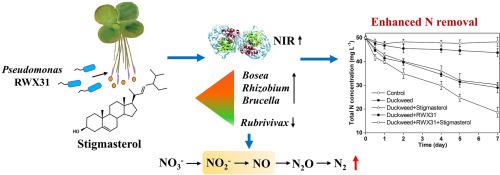当前位置:
X-MOL 学术
›
Environ. Pollut.
›
论文详情
Our official English website, www.x-mol.net, welcomes your
feedback! (Note: you will need to create a separate account there.)
Stigmasterol root exudation arising from Pseudomonas inoculation of the duckweed rhizosphere enhances nitrogen removal from polluted waters
Environmental Pollution ( IF 7.6 ) Pub Date : 2021-06-15 , DOI: 10.1016/j.envpol.2021.117587 Yufang Lu 1 , Herbert J Kronzucker 2 , Weiming Shi 1
Environmental Pollution ( IF 7.6 ) Pub Date : 2021-06-15 , DOI: 10.1016/j.envpol.2021.117587 Yufang Lu 1 , Herbert J Kronzucker 2 , Weiming Shi 1
Affiliation

|
Rhizospheric microorganisms such as denitrifying bacteria are able to affect ‘rhizobioaugmention’ in aquatic plants and can help boost wastewater purification by benefiting plant growth, but little is known about their effects on the production of plant root exudates, and how such exudates may affect microorganismal nitrogen removal. Here, we assess the effects of the rhizospheric inoculant strain RWX31 on the root exudate profile of the duckweed using gas chromatography/mass spectrometry. Compared to untreated plants, inoculation with RWX31 specifically induced the exudation of two sterols, stigmasterol and β-sitosterol. An authentic standard assay revealed that stigmasterol significantly promoted nitrogen removal and biofilm formation by the denitrifying bacterial strain RWX31, whereas β-sitosterol had no effect. Assays for denitrifying enzyme activity were conducted to show that stigmasterol stimulated nitrogen removal by targeting nitrite reductase in bacteria. Enhanced N removal from water by stigmasterol, and a synergistic stimulatory effect with RWX31, was observed in open duckweed cultivation systems. We suggest that this is linked to a modulation of community composition of type denitrifying bacteria in the rhizosphere, with a higher abundance of , and a lower abundance of . Our findings provide important new insights into the interaction of duckweed with the rhizospheric bacterial strain RWX31 and their involvement in the aquatic N cycle and offer a new path toward more effective bio-formulations for the purification of N-polluted waters.
中文翻译:

浮萍根际接种假单胞菌产生的豆甾醇根分泌物增强了污染水域的氮去除
反硝化细菌等根际微生物能够影响水生植物的“根际生物增强”,并且可以通过有利于植物生长来帮助促进废水净化,但人们对其对植物根系分泌物产生的影响以及这些分泌物如何影响微生物氮知之甚少移动。在这里,我们使用气相色谱/质谱法评估了根际接种剂菌株 RWX31 对浮萍根部分泌物特征的影响。与未处理的植物相比,接种 RWX31 特异性诱导两种甾醇(豆甾醇和 β-谷甾醇)的渗出。真实的标准测定表明,豆甾醇显着促进反硝化细菌菌株 RWX31 的脱氮和生物膜形成,而 β-谷甾醇则没有效果。对反硝化酶活性的测定表明,豆甾醇通过靶向细菌中的亚硝酸还原酶来刺激氮去除。在开放式浮萍栽培系统中观察到豆甾醇增强了水中的氮去除,并与 RWX31 具有协同刺激作用。我们认为这与根际反硝化细菌群落组成的调节有关,其中 的丰度较高,而 的丰度较低。我们的研究结果为浮萍与根际细菌菌株 RWX31 的相互作用及其参与水生氮循环提供了重要的新见解,并为更有效的生物制剂净化氮污染水体提供了新途径。
更新日期:2021-06-15
中文翻译:

浮萍根际接种假单胞菌产生的豆甾醇根分泌物增强了污染水域的氮去除
反硝化细菌等根际微生物能够影响水生植物的“根际生物增强”,并且可以通过有利于植物生长来帮助促进废水净化,但人们对其对植物根系分泌物产生的影响以及这些分泌物如何影响微生物氮知之甚少移动。在这里,我们使用气相色谱/质谱法评估了根际接种剂菌株 RWX31 对浮萍根部分泌物特征的影响。与未处理的植物相比,接种 RWX31 特异性诱导两种甾醇(豆甾醇和 β-谷甾醇)的渗出。真实的标准测定表明,豆甾醇显着促进反硝化细菌菌株 RWX31 的脱氮和生物膜形成,而 β-谷甾醇则没有效果。对反硝化酶活性的测定表明,豆甾醇通过靶向细菌中的亚硝酸还原酶来刺激氮去除。在开放式浮萍栽培系统中观察到豆甾醇增强了水中的氮去除,并与 RWX31 具有协同刺激作用。我们认为这与根际反硝化细菌群落组成的调节有关,其中 的丰度较高,而 的丰度较低。我们的研究结果为浮萍与根际细菌菌株 RWX31 的相互作用及其参与水生氮循环提供了重要的新见解,并为更有效的生物制剂净化氮污染水体提供了新途径。









































 京公网安备 11010802027423号
京公网安备 11010802027423号